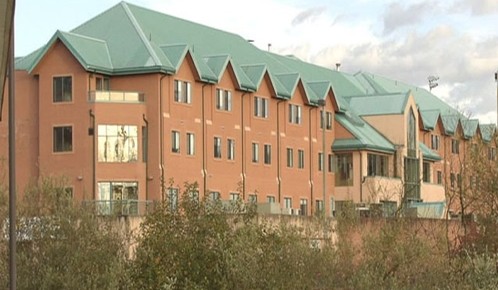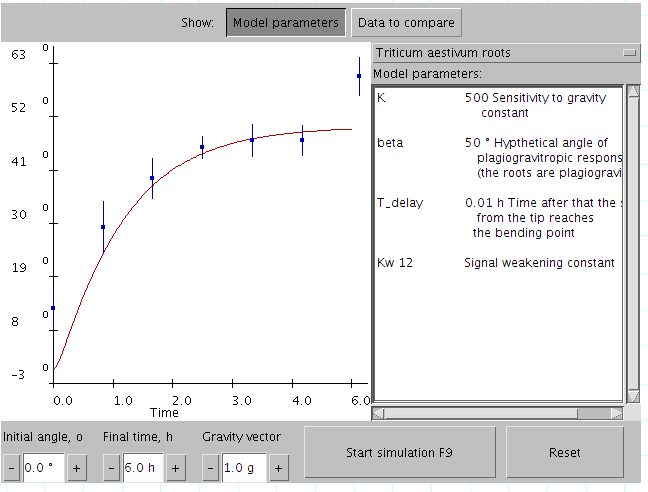|
Byl's Loop
The Byl's loop is an artificial lifeform similar in concept to Langton's loop. It is a two-dimensional, 5-neighbor cellular automaton with 6 states per cell, and was developed in 1989 by John Byl, from the Department of Mathematical Sciences of Trinity Western University. Details The Byl's loop was developed just a few years after Langton's simplification of Codd's automaton, which produced a simpler automaton that would reproduce itself in 151 time-steps. John Byl simplified Langton's automaton further, with an even smaller automaton that reproduced in just 25 time-steps. Byl's automaton consisted of an array of 12 chips — of which 4 or 5 could be counted as the instruction tape — and 43 transition rules, while Langton's device consisted of some 10×15 chips, including an instruction tape of 33 chips, plus some 190 transition rules. Essentially, the simplification consisted in using fewer cellular states (6 as compared with Langton's 8) and a smaller replicating loop (1 ... [...More Info...] [...Related Items...] OR: [Wikipedia] [Google] [Baidu] |
Artificial Life
Artificial life (often abbreviated ALife or A-Life) is a field of study wherein researchers examine systems related to natural life, its processes, and its evolution, through the use of simulations with computer models, robotics, and biochemistry. The discipline was named by Christopher Langton, an American theoretical biologist, in 1986. In 1987 Langton organized the first conference on the field, in Los Alamos, New Mexico. There are three main kinds of alife, named for their approaches: ''soft'', from software; ''hard'', from hardware; and '' wet'', from biochemistry. Artificial life researchers study traditional biology by trying to recreate aspects of biological phenomena. Overview Artificial life studies the fundamental processes of living systems in artificial environments in order to gain a deeper understanding of the complex information processing that define such systems. These topics are broad, but often include evolutionary dynamics, emergent properties of c ... [...More Info...] [...Related Items...] OR: [Wikipedia] [Google] [Baidu] |
Langton's Loops
Langton's loops are a particular "species" of artificial life in a cellular automaton created in 1984 by Christopher Langton. They consist of a loop of cells containing genetic information, which flows continuously around the loop and out along an "arm" (or pseudopod), which will become the daughter loop. The "genes" instruct it to make three left turns, completing the loop, which then disconnects from its parent. History In 1952 John von Neumann created the first cellular automaton (CA) with the goal of creating a self-replicating machine. This automaton was necessarily very complex due to its computation- and construction-universality. In 1968 Edgar F. Codd reduced the number of states from 29 in von Neumann's CA to 8 in his. When Christopher Langton did away with the universality condition, he was able to significantly reduce the automaton's complexity. Its self-replicating loops are based on one of the simplest elements in Codd's automaton, the periodic emitter. Specific ... [...More Info...] [...Related Items...] OR: [Wikipedia] [Google] [Baidu] |
Cellular Automaton
A cellular automaton (pl. cellular automata, abbrev. CA) is a discrete model of computation studied in automata theory. Cellular automata are also called cellular spaces, tessellation automata, homogeneous structures, cellular structures, tessellation structures, and iterative arrays. Cellular automata have found application in various areas, including physics, theoretical biology and microstructure modeling. A cellular automaton consists of a regular grid of ''cells'', each in one of a finite number of '' states'', such as ''on'' and ''off'' (in contrast to a coupled map lattice). The grid can be in any finite number of dimensions. For each cell, a set of cells called its ''neighborhood'' is defined relative to the specified cell. An initial state (time ''t'' = 0) is selected by assigning a state for each cell. A new ''generation'' is created (advancing ''t'' by 1), according to some fixed ''rule'' (generally, a mathematical function) that determines the new state ... [...More Info...] [...Related Items...] OR: [Wikipedia] [Google] [Baidu] |
Trinity Western University
, mottoeng = A Mighty Fortress Is Our God , established = Trinity Junior College (1962–1972), Trinity Western College (1972–1985), Trinity Western University (1986–present) , type = Private , endowment = CAD $22.4 million (2019) , president = Mark Husbands , provost = W. Robert Wood , students = 4000 , undergrad = 1900 , city = Langley, British Columbia , country = Canada , campus = Suburban/Rural < , colours = Gold & blue , sports_nickname = , academic_affiliations = [...More Info...] [...Related Items...] OR: [Wikipedia] [Google] [Baidu] |
Codd's Automaton
Codd's cellular automaton is a cellular automaton (CA) devised by the British computer scientist Edgar F. Codd in 1968. It was designed to recreate the computation- and construction-universality of von Neumann's CA but with fewer states: 8 instead of 29. Codd showed that it was possible to make a self-reproducing machine in his CA, in a similar way to von Neumann's universal constructor, but never gave a complete implementation. History In the 1940s and '50s, John von Neumann posed the following problem: *What kind of logical organization is sufficient for an automaton to be able to reproduce itself? He was able to construct a cellular automaton with 29 states, and with it a universal constructor. Codd, building on von Neumann's work, found a simpler machine with eight states. This modified von Neumann's question: *What kind of logical organization is ''necessary'' for an automaton to be able to reproduce itself? Three years after Codd's work, Edwin Roger Banks showed a 4-s ... [...More Info...] [...Related Items...] OR: [Wikipedia] [Google] [Baidu] |
Penguin Books
Penguin Books is a British publishing house. It was co-founded in 1935 by Allen Lane with his brothers Richard and John, as a line of the publishers The Bodley Head, only becoming a separate company the following year."About Penguin – company history" , Penguin Books. Penguin revolutionised publishing in the 1930s through its inexpensive paperbacks, sold through and other stores for sixpence, bringing high-quality fictio ... [...More Info...] [...Related Items...] OR: [Wikipedia] [Google] [Baidu] |
Physica D '', an international scientific journal for experimental and theoretical physics
{{dab ...
Physica may refer to: * Physics (Aristotle) * ''Physica'' (journal), a Dutch scientific journal :* ''Physica A'' :* ''Physica B'' ;* ''Physica C'' :* ''Physica D'' :* ''Physica E'' * ''Physica Scripta ''Physica Scripta'' is an international scientific journal for experimental and theoretical physics. It was established in 1970 as the successor of ''Arkiv för Fysik'' and published by the Royal Swedish Academy of Sciences (KVA). Since 2006, it ... [...More Info...] [...Related Items...] OR: [Wikipedia] [Google] [Baidu] |
Perspectives On Science And Christian Faith
''Perspectives on Science and Christian Faith'', subtitled ''Journal of the American Scientific Affiliation'', is the academic publication of the American Scientific Affiliation. Background The ASA's original constitution provided two goals for the ASA: "(1) to promote and encourage the study of the relationship between the facts of science and Holy Scriptures and (2) to promote the dissemination of the results of such studies." The establishment of the journal was seen as being in context of these goals.The Harmonious Dissonance of Evangelical Scientists: Rhetoric and Reality in the Early Decades of The American Scientific Affiliation , ''PSCF'' 50 (December 1998): 241-249 The journal is indexed in the [...More Info...] [...Related Items...] OR: [Wikipedia] [Google] [Baidu] |
American Scientific Affiliation
The American Scientific Affiliation (ASA) is a Christian religious organization of scientists and people in science-related disciplines. The stated purpose is "to investigate any area relating Christian faith and science." The organization publishes a journal, '' Perspectives on Science and Christian Faith'' which covers topics related to Christian faith and science from a Christian viewpoint. Members of the organization are from various movements, such as evangelicalism, and represent several Christian traditions including the Lutherans, Catholics, Methodists, Presbyterians, Baptists, and the Orthodox. The organization frequently runs seminars such as at Baylor University, the Faraday Institute for Science and Religion in Cambridge, England, and The Catholic University of America. History Scientists who were Christians and had concerns about the quality of Christian evangelism on the subject of religion and science formed the ASA in 1941. Irwin A. Moon originated the ... [...More Info...] [...Related Items...] OR: [Wikipedia] [Google] [Baidu] |
Java Applet
Java applets were small applications written in the Java programming language, or another programming language that compiles to Java bytecode, and delivered to users in the form of Java bytecode. The user launched the Java applet from a web page, and the applet was then executed within a Java virtual machine (JVM) in a process separate from the web browser itself. A Java applet could appear in a frame of the web page, a new application window, Sun's AppletViewer, or a stand-alone tool for testing applets. Java applets were introduced in the first version of the Java language, which was released in 1995. Beginning in 2013, major web browsers began to phase out support for the underlying technology applets used to run, with applets becoming completely unable to be run by 2015–2017. Java applets were deprecated by Java 9 in 2017. Java applets were usually written in Java, but other languages such as Jython, JRuby, Pascal, Scala, NetRexx, or Eiffel (via ... [...More Info...] [...Related Items...] OR: [Wikipedia] [Google] [Baidu] |

.jpg)



